Karthika Deepam
Karthika Deepam, Thrikarthika or Karthikai Vilakkidu is a festival of lights that is observed by Hindus of Kerala, Tamil Nadu and Sri Lanka. It falls in the month of Kārttikai (mid-November to mid-December) as per Tamil calendar. The full moon day of this Karthigai month is called Karthigai pournami. In Kerala, this festival is known as Thrikkarthika, celebrate to welcome Goddess Karthiyayeni (Chottanikkara Amma)Bhagavathi. In the rest of India, a related festival called Kartik Purnima is celebrated in a different date. It is celebrated in the name of 'Lakshabba' in the Nilgiris district of Tamil Nadu. The name of the festival born from the name of the god Kartikeya. In Tamil calendar the name of this month is called as Kārthikai (கார்த்திகை). In Telugu households of Andhra Pradesh, Telangana, Karthika Maasalu (month) is considered very auspicious. The Kartika month starts on the day of Deepawali. From that day till the end of the month, oil lamps are lit every day. On Karthika Puranam (full moon of Kartheeka month) oil lamp with 365 wicks, prepared at home, are lit in Lord Shiva temples. Apart from that, Kartika Puranam is read and fasting is observed till sunset, every day for the whole month. Swaminarayan Sampraday also celebrates this day with faith and fervor.[7]
| Karthika Deepam, Thrikarthika | |
|---|---|
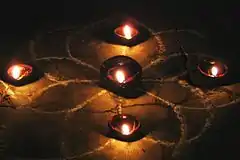 Agal vilakku (oil lamps) during the occasion of Karthika Deepam | |
| Observed by | Hindus of Andhra Pradesh, Telangana, Tamil Nadu, Kerala, Sri Lanka |
| Significance | Formation of Murugan, Celebrating Goddess Katyayani (Chottanikkara Amma) and Bhagavati |
| 2020 date | 29 November 2020[1] |
| Part of a series on |
| Hinduism |
|---|
 |
|
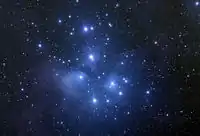
The story of six stars
Many legends and lyrical poetry have grown around this star. The six stars are considered in Indian mythology as the six celestial nymphs who reared the six babies in the Saravana tank which later were joined together to form the six faced Muruga. They are Dula, Nitatni, Abhrayanti, Varshayanti, Meghayanti and Chipunika. He is therefore called Karthikeya, the incarnation of Lord Shiva as his second son after Lord Ganesha. It is believed that Lord Shiva created Muruga from his 3rd eye[note 1] of six primary faces (Tatpurusam,[note 2] Aghoram,[note 3] Sadyojatam,[note 4] Vamadevam,[note 5] Eesanam,[note 6] Adhomukam[note 7]). It is believed that the six forms made into six children and each of them brought up by the six Karthigai nymphs (Śiva, Sambhūti, Prīti, Sannati, Anasūya and Kṣamā[2]) and later merged into one by his mother Parvati.
While merging he also formed into a six faced (Arumugam and twelve handed god. The Lord Murugan is also portrayed with his six plays[3] and worshiped with six names.
As the six nymphs helped in growing the child, Lord Shiva blessed immortality to the six nymphs as ever living stars on the sky. Any worship performed to this six stars is equal to worshiping Lord Muruga himself. They are worshiped by lighting up rows of oil lamps (Deepam) in the evening of the festival day around the houses and streets. Karthikai Deepam is also known as Kartikeya, or Muruga's birthday.
Other Mythological Stories and Literature on this 6 stars Pleiades in folklore and literature or Kṛttikā.[4]
History
One of the earliest references to the festival is found in the Aganaanooru, a book of poems, which dates back to the Sangam Age (200 B.C. to 300 A.D.). The Aganaanooru clearly states that Karthigai is celebrated on the full moon day (pournami) of the month of Karthigai, as per South Indian calendar. It was one of the most important festivals (peruvizha) of the ancient Tamils, including now the areas of modern Kerala too. Avaiyyar, the renowned poet of those times, refers to the festival in her songs. Karthikai Deepam is one of the oldest festivals celebrated by Tamil people. The festival finds reference in Sangam literature like Akanaṉūṟu and the poems of Auvaiyar.[5] Karthigai is referred in Sangam literature as Peruvizha.[6]
Mythological references
Lord Shiva appeared as an endless flame of light before Lord Vishnu and Lord Brahma, who each considered himself supreme and said that the matter could be tested if the two could search for Lord Shiva's Head and feet. Lord Vishnu took the form of a boar(Sanskrit:Varaha, Tamil:Varaham(pandri) ) and delved deep into the earth, Lord Brahma that of a swan(Sanskrit:Hansa, Tamil:Annam) and flew towards the skies. Lord Vishnu failed in his search and returned. But Lord Brahma, chancing upon a piece of Thazhambu, a flower, learnt from it that it had been floating down for thirty thousand years from Lord Shiva's head. He seized upon this and claimed to Lord Shiva that he had seen the other's top. Lord Siva realized the falsehood and pronounced that there would never be a temple for Lord Brahma in this world. He also interdicted the use of the flower Thazhambu in his worship. Lord Shiva appeared as a flame, this day is called Karthikai Maha Deepam.[7]
Celebrations
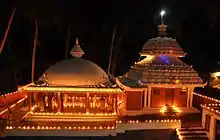
Rows of Agal vilakkus (Clay Oil lamps) are lit in every house. Karthigai is essentially a festival of lamps. The lighted lamp is considered an auspicious symbol. It is believed to ward off evil forces and usher in prosperity and joy. While the lighted lamp is important for all Hindu rituals and festivals, it is indispensable for Karthigai. This festival is also celebrated to commemorate the bonding between brothers and sisters in south India(analogous to Bhaiya-Dhuj and Raakhi). Sisters pray for the prosperity and success of their brothers and light lamps to mark the occasion.
In Telugu households, Kaartheeka maasam (month) is considered very auspicious. The Kartheeka month starts on the day of Deepawali. From that day till the end of the month, oil lamps are lit every day. On Kartheeka Pournami (full moon of Kartheeka month) oil lamp with 365 wicks, prepared at home, are lit in Lord Shiva temples. Apart from that, Kaartheeka puranam is read and fasting is observed till sunset, every day for the whole month.
Celebrations at Tiruvannamalai, Tamil nadu and Koneshwaram, Trincomalee
Thiruvannamalai Maha Deepam will be lit at around 6 pm at the top of 2668 ft high holy mountain. The entire Mountain is Shiva Linga. Maha Deepam will be lit using nearly 3500 kg of Ghee. Sri Arthanareeshwara will bless devotees in the Temple at the time of lighting the Maha Deepam. The Maha Deepam will be visible around the Holy Mountain in a radius of 35 km. Lakhs of devotees will perform 16 km Girivalam (circumambulation of the holy mountain). The Moist Black Ash (what they call as 'Mai' in Tamil) that remains after the lighting of the Ghee & Cotton Wick will be distributed as Prasadam to devotees on the Marghazhi Arudra Darisanam day.[8]
As in Tiruvannamalai, Tamil Nadu, Karthigai festival is also famous in Koneshwaram, Trincomalee, Sri Lanka.[9] The festival is celebrated for three days. The first day is called Appa Karthigai, the second Vadai Karthigai and the final day is called Thiru Karthigai, widely considered as the Karthigai day, when the main pooja is performed.[10] On Karthigai day, a huge fire lamp is lit up on the hill(in both temples), visible for several kilometers around. The fire (deepam) is called Mahadeepam. Hindu devotees visit the place, to pray and make offerings to lord Shiva. In 2016, due to the Maha Kumbh Mela of Ujjain Simhastha, Karthikai Deepam will hold special significance, being celebrated on 12 December 2016, which being a Monday is symbolically attributed to God Shiva, of the twelve Jyotirlinga.[11]
Homemade fireworks
| Homemade karthikai deepam firework (கார்த்திகை சுற்று) | |
|---|---|
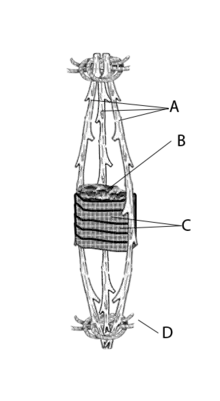 Sample Construction | |
| Label Details | |
| A | The 3 twigs which hold the charcoal pack |
| B | The exposed charcoal to ignite easily |
| C | The layered charcoal packed in jute sack pieces |
| D | The rope binding |
| Height | Height might vary from 10 inches to 12 inches or more |
| Width | 3 to 4-inch width of the charcoal package |
Kārtikai chutru or Kārtikai chuḻaṟtu is a homemade charcoal-based hand-rotating firecracker. This is crafted by youngsters and elders at the time of this festival at rural cities at Tamil Nadu[12] state in India. This cracker is very safe as it is made of Charcoal and constructed as a non-explosive craft. This cracker is handled with a long rope and rotated over the head clockwise, anti-clockwise, zig zag and any other pattern to make the display more fun. To maintain safety, the ropes used are either coir rope or jute rope. While rotating the ignited set-up of this cracker with the wind makes the charcoal to burn and split into small pieces which falls down. This burning effect can be compared with Chimney starter.[note 8] This display can be compared with a fire performance,[note 9] but the rope will not be ignited.
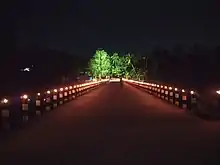
This cracker is made of crushed and packed charcoal into Coconut shell or using a piece of Gunny sack. The packing is tightly placed inside 3 twigs or flexible wood stick or plant stem. The twigs are tied with ropes with a safety distance. Few burning charcoal is placed over the packing and blown hard or rotated until The packing gets slowly ignited. While the packing started ignited then it can be rotated faster with help of the rope. The falling pieces of burning charcoal pieces from the packing gives a fire cracker effect. The charcoal mixture can be mixed with dried palm flower pieces for more sparkling effects.. Crushed charcoal can be packed into layers of jute sack (Gunny sack) pieces
Notes
- Third eye The third eye of Lord Shiva from all his six faces were used to create Lord Muruga as his son
- Tatpurusha The face of Concealing Grace
- Aghora The face of annihilation
- Sadyojata The face of Creation
- Vamadeva The face of Preservation/Healing/Dissolution/Rejuvenation
- Ishana The face of Revealing Grace
- The 6th face of shiva specified in literature named sri kanda puranam (Skanda Purana)
- Chimney starter is similar kind of mechanism used, but it uses fuel to burn charcoal
- Rope fire performance is another form of fire dancing and twirling with fired ropes which needs special skills, because the rope is ignited with fuel
References
- Karthigai Deepam Panchang
- The Sacred Books of the Hindus, Vol 21, Rai Bahadur Srisa Chandra Vidyaranya, p29, The Panini Office (Bhuvaneswari Asrama), 1918.
- Six Abodes of Murugan The six spiritual temples (homes) of Lord Murugan
- Other Mythological Stories and Literature on this 6 stars Pleiades in folklore and literature
- The Hindu: Glow of prosperity
- V., Balambal (1998). Studies in the History of the Sangam Age. New Delhi: Kalinga Publications. p. 6. ISBN 978-8185163871.
- Lakhs of devotees witness lighting of Karthigai Deepam at Tiruvannamalai The Hindu News Paper Article 10 December 2019
- K, Kandaswamy. "Karthigai Deepam in Thiruvannamalai". Live Trend. K Kandaswamy. Retrieved 23 November 2017.
- Lakhs witness Karthigai Deepam The Hindu News Paper Article 28 November 2012
- Tiruvannamalai Karthigai Maha Deepam - The Story Behind, Significance, Pooja Procedure and Food Recipes
- Karthigai Deepam 12 December 2016(Monday)
- Improvised firework adds colour to Kaarthigai Deepam The Hindu news paper December 13, 2008. This news paper refers to the Cuddalore district and city named Cuddalore where it is popular even these days people celebrate the festival with this firework
External links
| Wikimedia Commons has media related to Karthigai Deepam. |
In Regional new year it is mentioned (under Malayali-Kerala)that Vishu is the new year, But Chingam is the start of new year in their calendar. Vishu (Malayalam: വിഷു) is a Hindu festival primarily celebrated in the Indian state of Kerala, which marks the beginning of the harvest year.(From Wiki itself copied)
